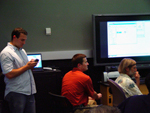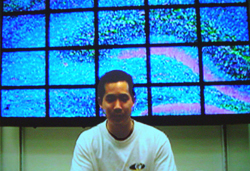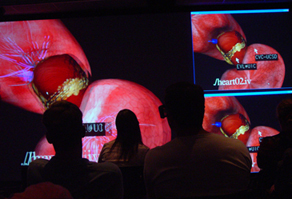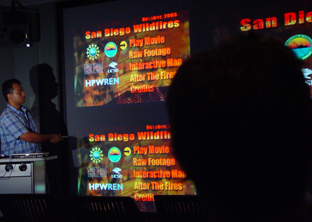UCSD Division Launches Collaborative Visualization Center
|
9.25.04 --In collaboration with the Jacobs School of Engineering, the UCSD division of Calit² launched the Collaborative Visualization Center in a three-hour event this week describing facility capabilities and presenting demonstrations of their use from various disciplinary areas. In opening comments, UCSD division director Ramesh Rao said enthusiastically that "we've already discovered uses and applications of this facility that we hadn't anticipated during the planning process."
|
According to Jacobs dean Frieder Seible, "This facility will not only provide new ways for researchers to visualize the wealth of data they have but it will foster new research. We also believe this facility can serve as a small command-and-control center as part of a distributed network of such centers to support community needs related to homeland defense." (For facility capabilities, see the sidebar to this article.)
The project was handed over to Calit² to plan and use, said Seible, as a "training exercise" for similar capabilities in the new Calit² building slated for occupancy in spring 2005. He admitted that two years ago, when the planning began, the goals for the facility were vague, but, shaking his head, he was clearly marveling at its potential as demonstrated by early friendly users.
The event featured several demonstrations:
. Offshore 3-D perspective of the La Jolla canyon. Graham Kent, Scripps Institution of Oceanography (SIO), presented this demo distinguished by its integration of three types of data: LIDAR (high-resolution elevation data), bathymetry data of the ocean floor, and aerial photographs draped over the elevation data. "What's unique here," said Graham, "is hanging seismic data off the bathymetry data to look for relationships between the two. There's a lot of debate about how sand is moving around beaches in San Diego. The bathymetry vis-à-vis the La Jolla cliffs shows erosion -- canyons look like big sink holes for sand." Similarly, he said, you might correlate the relationship between schools of fish and faults. "Fish and faults seem to go hand in hand," he said.
|
. Calit² building visualization. Sheldon Brown, Visual Arts, presented this interactive 3-D model and multimedia animation demo. "To our surprise, constructing this virtual environment was more like constructing the building on the construction site than creating a film." One of the students key to this project was recent UCSD graduate Ben Maggos who was a Calit² summer undergraduate scholar. Conversion among data types presented one of the biggest challenges.
. Remote collaboration with the National Center for Microscopy and Imaging Research. This presentation, with Aaron Chin at CVC and David Lee at NCMIR, demonstrated the use of DVTS technology. Chin described the link as a "persistent portal to enable conversations at any time." On the other side of this link, Lee discussed NCMIR's development of telescience technology, which enables real-time remote access by others of their high-voltage electron microscope and enables them to access an even more powerful one in Osaka, Japan. He also described recent NCMIR trials with low-latency, high-definition TV that enables a higher-resolution "window" into the specimen on the remote microscope.
. Smart Vivarium. Serge Belongie, UCSD Computer Vision Lab, presented his Calit²-funded project to prototype video monitoring of laboratory mice. "A typical vivarium has 100s to 1000s of cages, making manual, close monitoring of each mouse impossible," said Belongie. "Our Smart Vivarium technology holds the promise of automating this process. Its benefits include improving the life history of animals in research, more targeted and thorough biomedical investigations, and continuous monitoring for longitudinal studies." Belongie's research interests are related to computer vision, pattern recognition, embedded systems, and distributed systems.
. Long-distance collaboration between display-rich environments. Atul Nayak, SIO, worked with a colleague at the Electronic Visualization Laboratory (EVL) at the University of Illinois at Chicago to demonstrate various collaboration technologies. For the audience in the CVC, EVL demonstrated its "Continuum," which includes a whiteboard, Access Grid, Polycom videoteleconferencing system, and Geowall (a passive stereo system that arose out of the geoscience community). He also demonstrated a project called Quick World, in this case in the form of an interactive animation of a heart and lungs, to enable elementary school children to become more knowledgeable about science.
. San Diego fires of October 2003. Atul Nayak showed time-lapse movies of several days of intense fires in three locations in San Diego County last fall. The movies were based on video captured from several cameras positioned on the High Performance Wireless Research and Education Network.
|
. Applications for homeland security and crisis mitigation. Ganz Chockalingam demonstrated a Mobile Command and Control Center application, an end-to-end architecture allowing first responders to efficiently collect, manage, and disseminate information within emergency response networks and to the general public. It allows responders to collect information in the form of pictures, videos, and audio clips, automatically time and location stamp them, and populate a GIS database without user intervention. Chockalingam also demonstrated a "511" system (http://traffic.calit2.net) that allows for dynamic routing and dispatch of first responders based on current traffic conditions. The 511 system, initially deployed by Calit² during Super Bowl 2003 at the request of the San Diego Police Department, has been operational for almost two years. It is available to the general public and receives about 50,000 calls each month.
The event was attended by some 50 UCSD faculty, students, and staff, representing departments ranging from the sciences, math, and engineering to visual arts; UCI division director Albert Yee; collaborators from the University of Illinois at Chicago, including Tom DeFanti and Maxine Brown, and the National Center for Supercomputing Applications; and many Calit² staff.




